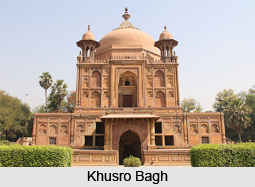 Khusro Bagh as the name conforms is a garden with large walls that is very much close to the Allahabad Junction Station. The Bag is may be spotted surrounding the tombs of Khusrau Mirza the elder son of Jahangir who deceased in the year 1622. The bag even includes the tomb of Shah Begum, the then Khusrau`s mother who passed away in the year 1604, a Rajput princess and Jahangir`s first wife, and that of Princess Sultan Nithar Begam Khusrau`s sister.
Khusro Bagh as the name conforms is a garden with large walls that is very much close to the Allahabad Junction Station. The Bag is may be spotted surrounding the tombs of Khusrau Mirza the elder son of Jahangir who deceased in the year 1622. The bag even includes the tomb of Shah Begum, the then Khusrau`s mother who passed away in the year 1604, a Rajput princess and Jahangir`s first wife, and that of Princess Sultan Nithar Begam Khusrau`s sister.
The three sandstone mausoleums confined within the confines of the garden presents a discriminating example of Mughal architecture. The main entrance is intricately designed and the surrounding gardens as well as the three-tier tomb of Sultan Begum, who left the mortal plain in the year 1604, have been attributed to Aqa Reza, Jahangir`s principal court artist. Shah Begum whose original name was Man Bai was the daughter of Raja Bhagvan Das of Amber. She was inexpressibly distressed when her husband Jahangir and son Khusrau were engaged in abysmal tiffs and discords; she committed suicide in 1604 by having large portion of opium. Her tomb was designed in 1606 by Aqa Reza and is a three storied terrace plinth without a main mound, inviting comparisons with Fatehpur Sikri by experts.
Beside the tomb of the Begum is quietly placed the tomb of Khusrau`s sister, Nithar. When it comes to the architectural feature, this thrives to be the most elaborate of the three that lies basically on an elevated platform and is adorned with panels depicting the scalloped arch motif. Within the plinth are rooms whose ceilings have been elaborately painted with stars in concentric circles. The central room has on its walls floral decorations depicting Persian cypresses, flowers and plants.
Enclosure wall and Gateway of Khusru Bagh the tomb of Khusrau, is the last of the three tombs in Khusro Bagh. In the previous era Khusro was imprisoned within the garden after he strongly rebelled against his father, Jahangir and rebellion against his father meant revolting against the royalty in 1606. As he attempted to escape and he was duly blinded as per the instructions of Jahangir and was later killed in the year 1922 on the orders of Khusrau`s brother and Jehangir`s third son Prince Khurram, who later on became the Emperor Shah Jahan. The tomb is characterised by fretwork windows and the tomb of his mare is not far from his own tomb.
The tomb was finally completed in the year 1622, while that of Nithar Begum`s, which lies between Shah Begum`s and Khusrau`s tombs and was built with the instructions in 1624-25. Nithar`s mausoleum is enshrouded by an atmosphere of comprehensive emptiness and it neither does contain her tomb within it. As the Revolt of 1857 broke out the Khusrau Bagh became the headquarters of the Sepoys under Maulvi Liyakat Ali who adopted the charge as the Governor of liberated Allahabad. However the scenario at Allahabad was entirely different where the Mutiny was swiftly put down and Khusro Bagh was again re-conquered by the British troops. The garden has now lent its name to the surrounding locality of Khusrobagh, which is now bustling township.




